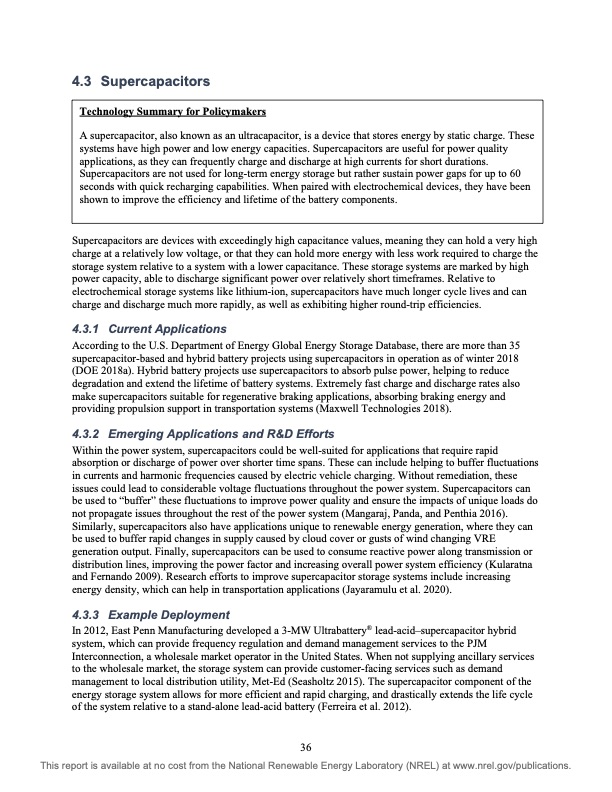
PDF Publication Title:
Text from PDF Page: 043
4.3 Supercapacitors Technology Summary for Policymakers A supercapacitor, also known as an ultracapacitor, is a device that stores energy by static charge. These systems have high power and low energy capacities. Supercapacitors are useful for power quality applications, as they can frequently charge and discharge at high currents for short durations. Supercapacitors are not used for long-term energy storage but rather sustain power gaps for up to 60 seconds with quick recharging capabilities. When paired with electrochemical devices, they have been shown to improve the efficiency and lifetime of the battery components. Supercapacitors are devices with exceedingly high capacitance values, meaning they can hold a very high charge at a relatively low voltage, or that they can hold more energy with less work required to charge the storage system relative to a system with a lower capacitance. These storage systems are marked by high power capacity, able to discharge significant power over relatively short timeframes. Relative to electrochemical storage systems like lithium-ion, supercapacitors have much longer cycle lives and can charge and discharge much more rapidly, as well as exhibiting higher round-trip efficiencies. 4.3.1 Current Applications According to the U.S. Department of Energy Global Energy Storage Database, there are more than 35 supercapacitor-based and hybrid battery projects using supercapacitors in operation as of winter 2018 (DOE 2018a). Hybrid battery projects use supercapacitors to absorb pulse power, helping to reduce degradation and extend the lifetime of battery systems. Extremely fast charge and discharge rates also make supercapacitors suitable for regenerative braking applications, absorbing braking energy and providing propulsion support in transportation systems (Maxwell Technologies 2018). 4.3.2 Emerging Applications and R&D Efforts Within the power system, supercapacitors could be well-suited for applications that require rapid absorption or discharge of power over shorter time spans. These can include helping to buffer fluctuations in currents and harmonic frequencies caused by electric vehicle charging. Without remediation, these issues could lead to considerable voltage fluctuations throughout the power system. Supercapacitors can be used to “buffer” these fluctuations to improve power quality and ensure the impacts of unique loads do not propagate issues throughout the rest of the power system (Mangaraj, Panda, and Penthia 2016). Similarly, supercapacitors also have applications unique to renewable energy generation, where they can be used to buffer rapid changes in supply caused by cloud cover or gusts of wind changing VRE generation output. Finally, supercapacitors can be used to consume reactive power along transmission or distribution lines, improving the power factor and increasing overall power system efficiency (Kularatna and Fernando 2009). Research efforts to improve supercapacitor storage systems include increasing energy density, which can help in transportation applications (Jayaramulu et al. 2020). 4.3.3 Example Deployment In 2012, East Penn Manufacturing developed a 3-MW Ultrabattery® lead-acid–supercapacitor hybrid system, which can provide frequency regulation and demand management services to the PJM Interconnection, a wholesale market operator in the United States. When not supplying ancillary services to the wholesale market, the storage system can provide customer-facing services such as demand management to local distribution utility, Met-Ed (Seasholtz 2015). The supercapacitor component of the energy storage system allows for more efficient and rapid charging, and drastically extends the life cycle of the system relative to a stand-alone lead-acid battery (Ferreira et al. 2012). 36 This report is available at no cost from the National Renewable Energy Laboratory (NREL) at www.nrel.gov/publications.PDF Image | USAID GRID-SCALE ENERGY STORAGE TECHNOLOGIES PRIMER

PDF Search Title:
USAID GRID-SCALE ENERGY STORAGE TECHNOLOGIES PRIMEROriginal File Name Searched:
76097.pdfDIY PDF Search: Google It | Yahoo | Bing
Turbine and System Plans CAD CAM: Special for this month, any plans are $10,000 for complete Cad/Cam blueprints. License is for one build. Try before you buy a production license. More Info
Waste Heat Power Technology: Organic Rankine Cycle uses waste heat to make electricity, shaft horsepower and cooling. More Info
All Turbine and System Products: Infinity Turbine ORD systems, turbine generator sets, build plans and more to use your waste heat from 30C to 100C. More Info
CO2 Phase Change Demonstrator: CO2 goes supercritical at 30 C. This is a experimental platform which you can use to demonstrate phase change with low heat. Includes integration area for small CO2 turbine, static generator, and more. This can also be used for a GTL Gas to Liquids experimental platform. More Info
Introducing the Infinity Turbine Products Infinity Turbine develops and builds systems for making power from waste heat. It also is working on innovative strategies for storing, making, and deploying energy. More Info
Need Strategy? Use our Consulting and analyst services Infinity Turbine LLC is pleased to announce its consulting and analyst services. We have worked in the renewable energy industry as a researcher, developing sales and markets, along with may inventions and innovations. More Info
Made in USA with Global Energy Millennial Web Engine These pages were made with the Global Energy Web PDF Engine using Filemaker (Claris) software.
Sand Battery Sand and Paraffin for TES Thermo Energy Storage More Info
| CONTACT TEL: 608-238-6001 Email: greg@infinityturbine.com | RSS | AMP |